#city sustainability
Explore tagged Tumblr posts
Text
Exploring the Future of Saskatoon's Green Spaces: CALL TO ACTION

View On WordPress
#Biodiversity Conservation#biodiversity management#carbon sequestration#citizen activism#citizen engagement#City Council#City Development#city governance#City planning#city sustainability#Climate Resilience#Community Empowerment#Community Engagement#Community Feedback#Community Participation#conceptual master plans#Conservation Efforts#ecological assessment#ecological balance#Ecological Monitoring#Ecological Resilience#Ecological Restoration#ecological value#ecosystem health#ecosystem management#Ecosystem Preservation#ecosystem services#environmental advocacy#environmental awareness#environmental conservation
0 notes
Text
"In China, a landscape architect is reimagining cities across the vast country by working with nature to combat flooding through the ‘sponge city’ concept.
Through his architecture firm Turenscape, Yu has created hundreds of projects in dozens of cities using native plants, dirt, and clever planning to absorb excess rainwater and channel it away from densely populated areas.
Flooding, especially in the two Chinese heartlands of the commercial south and the agricultural north, is becoming increasingly common, but Yu says that concrete and pipe solutions can only go so far. They’re inflexible, expensive, and require constant maintenance. According to a 2021 World Bank report, 641 of China’s 654 largest cities face regular flooding.
“There’s a misconception that if we can build a flood wall higher and higher, or if we build the dams higher and stronger, we can protect a city from flooding,” Yu told CNN in a video call. “(We think) we can control the water… that is a mistake.”
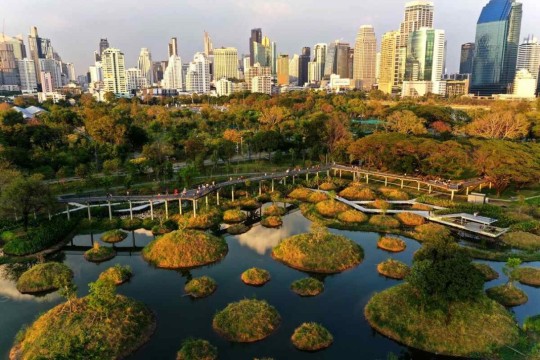
Pictured: The Benjakitti Forest Park in Bangkok
Yu has been called the “Chinese Olmstead” referring to Frederick Law Olmstead, the designer of NYC’s Central Park. He grew up in a little farming village of 500 people in Zhejiang Province, where 36 weirs channel the waters of a creek across terraced rice paddies.
Once a year, carp would migrate upstream and Yu always looked forward to seeing them leap over the weirs.
This synthesis of man and nature is something that Turenscape projects encapsulate. These include The Nanchang Fish Tail Park, in China’s Jiangxi province, Red Ribbon Park in Qinghuandao, Hebei province, the Sanya Mangrove Park in China’s island province of Hainan, and almost a thousand others. In all cases, Yu utilizes native plants that don’t need any care to develop extremely spongey ground that absorbs excess rainfall.
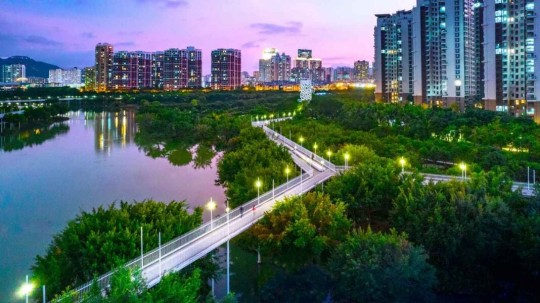
Pictured: The Dong’an Wetland Park, another Turescape project in Sanya.
He often builds sponge projects on top of polluted or abandoned areas, giving his work an aspect of reclamation. The Nanchang Fish Tail Park for example was built across a 124-acre polluted former fish farm and coal ash dump site. Small islands with dawn redwoods and two types of cypress attract local wildlife to the metropolis of 6 million people.
Sanya Mangrove Park was built over an old concrete sea wall, a barren fish farm, and a nearby brownfield site to create a ‘living’ sea wall.
One hectare (2.47 acres) of Turenscape sponge land can naturally clean 800 tons of polluted water to the point that it is safe enough to swim in, and as a result, many of the sponge projects have become extremely popular with locals.
One of the reasons Yu likes these ideas over grand infrastructure projects is that they are flexible and can be deployed as needed to specific areas, creating a web of rain sponges. If a large drainage, dam, seawall, or canal is built in the wrong place, it represents a huge waste of time and money.
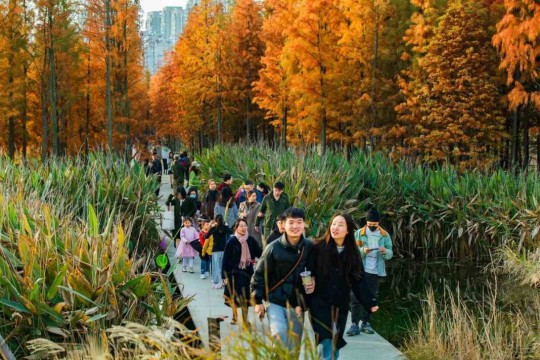
Pictured: A walkway leads visitors through the Nanchang Fish Tail Park.
The sponge city projects in Wuhan created by Turenscape and others cost in total around half a billion dollars less than proposed concrete ideas. Now there are over 300 sponge projects in Wuhan, including urban gardens, parks, and green spaces, all of which divert water into artificial lakes and ponds or capture it in soil which is then released more slowly into the sewer system.
Last year, The Cultural Landscape Foundation awarded Yu the $100,000 Oberlander Prize for elevating the role of design in the process of creating nature-based solutions for the public’s enjoyment and benefit."
-via Good News Network, August 15, 2024
#china#wuhan#thailand#bangkok#landscape#wetlands#sponge city#landscape architecture#flooding#climate action#parks#public park#green architecture#sustainability#good news#hope
1K notes
·
View notes
Text
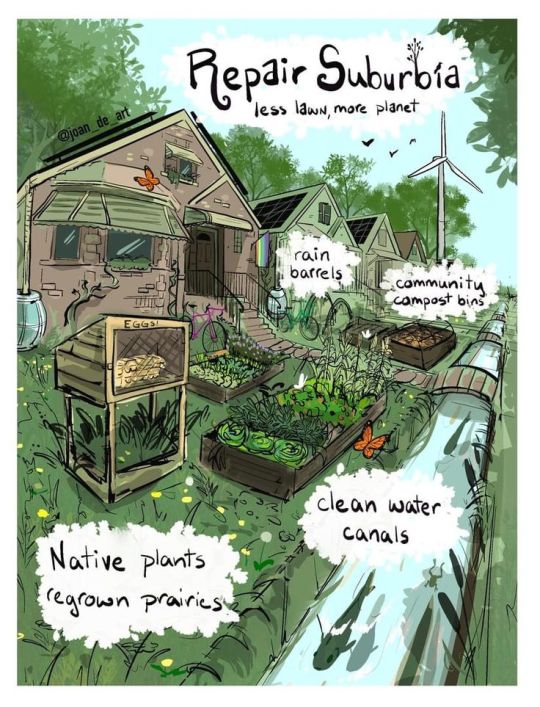
Little vision for a more beautiful, sustainable, tactile future.
3K notes
·
View notes
Text
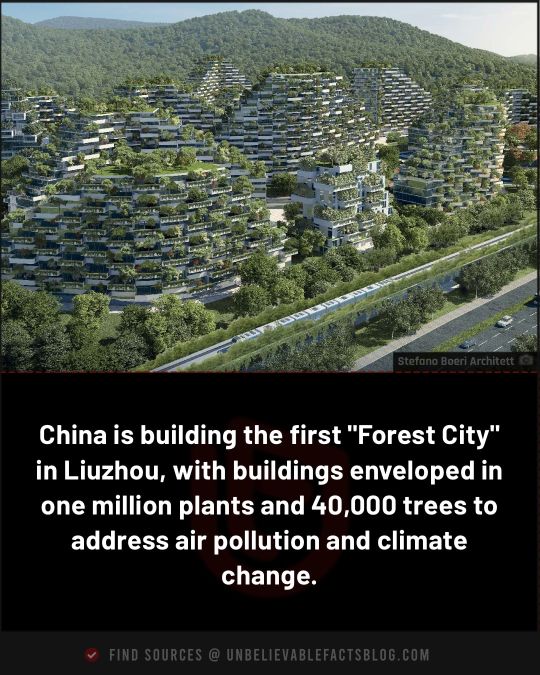
#China#Forest City#Liuzhou#urban planning#green architecture#air pollution#climate change#sustainability#environment#innovation
393 notes
·
View notes
Text
Solarpunk Cities vs Solarpunk Villages

One of those internal contradictions of Solarpunk is, that Solarpunk loves at ones a very urban aesthetic, while also kinda loving the idea of rural living - just without all the rural people out there right now.
If you look at Solarpunk art, yes, you will see some art with skyscrapers overgrown with trees (that again, would not be happy on that skyscraper, do not do that to the poor tree!), a lot of art also shows small settlements surrounded by fields and such. Classical rural settings.
Now, when I posted a while ago about including rural living people into leftist causes, a lot of folks got quite angry with me over it. Because according to quite a lot of tumblrites, obviously everyone who lives rurally is inherently racist, sexist, and queerphobic, other than the queer people who had the bad luck being born rurally and cannot move. But everyone else! And because a lot of leftists have not quite understood the entire "class solidarity" thing, the general thought in those cases is not to talk to people, but to just "fuck them and leave them to die".
I will leave my disagreement with this on: "Yeah, actually, class solidarity is super important. Read up on it" for now, because I want to talk about mainly the advantages and disadvantages on either form of building a solarpunk society.
Cities have one major advantage: In a lot of ways they are a whole lot more sustainable. Which makes sense, if you think about it. Basically, in a city, a whole lot of people are living closer together, so building the infrastructure is just so much easier. You need so much less of everything to provide people who live in multi-household buildings with water, eletrcitity, heating and internet. Because you basically just need one accesspoint for everything to the building. And general in a city you will have a lot more multi-household buildings.
Even without those though: Population density is a lot stronger in cities. Duh. So even if everyone was living in a single-household home (which is not really the Solarpunk ideal) those are closer together and hence you still need less material and power to provide those things.
It is also easier to provide other types of infrastructure, such as schools, markets, and hospitals. Even stuff just like abilities to connect with other folks... It is just easier to do in a city than in a rural area.
However, a lot of Solarpunk is also about empowering people to grow their own food and such and be more self-sufficient. And this, obviously, becomes a lot easier if the people live in a less densely populated area.
Generally: Once you go out of the city - no matter how much you design the city planning around creating enough green spaces and such - you just will be closer to nature. It is a simple fact. You can more easily interact with nature, can more easily put out stuff like animals. And obviously it is easier to grow and cultivate all sorts of produce.
Don't get me wrong: Yes, we absolutely can create food forests in cities - but still, there is a lot more room in rural areas to cultivate food.
See, the main thing with Solarpunk cities is, that they still will not be fully self-sustainable. Yes, absolutely, we can cultivate some food in greenhouses, on rooftops and in foodforests - but it will not be enough to feed an entire city. Meaning: There will be people in rural areas, to grow and cultivate food.
Mind you, ideally we will absolutely bring down meat consumption. While I am not a big fan of the idea of a fully vegan future (for reasons I went into multiple times: some people can for chronic sicknesses, or disabilities not go fully vegan, and yes, I personally also see value in cultural stuff that involves meat), I do think we will eventually reduce meat consumption a lot. So we will need a lot less room to grow stuff - because right now a lot of vegetables (especially corn) are consumed by livestock. So reducing livestock will reduce the need for produce in many regards.
We can because of this rewild a lot of area that currently is used to grow corn and such.
Still. One way or another: some people will need to farm. The question is just how many. Because yes, we can automate a whole lot of stuff - but that brings us back to the good old question of us being alienated from our food. Sure, if we cultivate some food where people are, this might be better... But we definitely can philosophically discuss whether it would not be better for us as a species to always cultivate our own food. Especially as we know that food that is grown in mixed fields and under concepts of permacultre are a lot harder to harvest automatically - but much better for the environment.
So, some people will need to be out there for farmwork. The question just remains: How many?
Because exiling some folks from society to grow food and isolate them seems to be rather bad in taste too, right?
And there definitely is some arguments for some people living more rurally. It just is harder to create as a context.
And sure, if we ever got to the Solarpunk future, chances are, things will come to be naturally. However, it is still worth thinking about it and evaluating it.
#solarpunk#lunarpunk#rural living#urban living#urban landscape#city#village life#agrarian#agriculture#food forest#sustainable living#sustainable farming#infrastructure#city planning
91 notes
·
View notes
Text
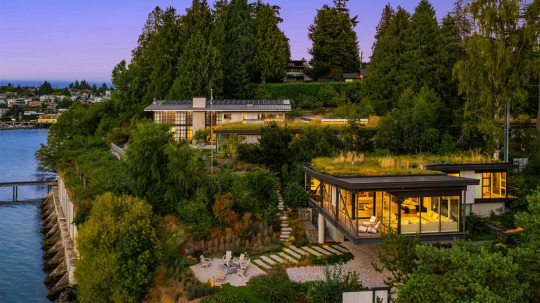
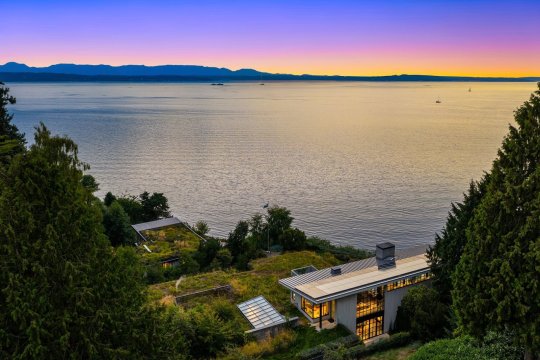














"The Bluff," 4315 W Semple St, Seattle, WA, United States,
Deforest Architects,
Interiors: Design Group, Lucas Interior,
Charles Anderson Landscape Architecture.
#art#design#architecture#interiors#interiorsdesign#luxury house#luxury home#luxury pad#sustainable architecture#seattle#thebluff#deforest architects#design group#lucas interiors#mark vadon#city-retreat#retreat
150 notes
·
View notes
Text
obviously lin ling & yang cheng parallels go crazy but og nice & yang cheng foils are so compelling. nice kills himself knowing to some extent that his image will survive (he did the pose!). yang cheng, in one way or another, kills himself believing it's the Only way his image can survive. the image one size too big for both him & the man it was tailored for. larger than both life & death. the only thing that can tower over a hero should be trust, and it is, but how tragic is it that the only time they can truly trust themselves is when they teach themselves how to die?
#tbhx spoilers#tbhx#to be hero x#yang cheng#tbhx nice#yes this is a reference to brand new city by mitski#i don't listen to her as much as i used to because i love myself but i will never let go of lush#ultimately both nice & yang cheng get what they want#because nice's legacy is forgotten in the commoner's wake#& yang cheng's face untainted by esoul's mask will eventually be forgotten#we've seen the trust system revive/sustain the Trademark of different heroes and clearly it's happened before#erm actually the illusion of free choice..... the juxtapositional dichotomy of it all...........
40 notes
·
View notes
Text
Exciting news from Arizona! The opening of the Eleven Mile Solar Center marks a $1 billion investment in clean energy by ACPMember OrstedUS The solar & energy storage project is set to power 65,000 homes. Take a look at the project celebration.
#clean energy#solar energy#sustainable development#investing#capitalism#finance#baking#city#commercial#clouds
66 notes
·
View notes
Text
reminder that fighting for climate solutions means fighting for public health.
switching to clean energy means less air pollution and significantly less deaths associated with fossil fuel extraction
green, localized, and walkable neighborhoods with accessible transport is good for physical, mental, social, and emotional health
cutting down the beef and dairy industries and eating more plant based (for those who can) is better for health of individuals
fighting for unionized labor in good, clean jobs means less stress in people's daily lives which leads to less stress-related illness and injury
Fight for your neighbors, fight for the planet
#solarpunk#sustainability#climate change#climate crisis#activism#walkable communities#walkable cities#plant based#clean energy
550 notes
·
View notes
Text
Take a breath today. Explore Harmony 17, a city where human creativity and AI planning thrive together. It is a glimpse of a hopeful future we could build. Read the story: https://wp.me/p19z04-SX

#AI and humanity#collaborative future#empathy ai#future cities#harmony 17#quantum gardening#street poetry#Sustainable Living#the signal#utopia
28 notes
·
View notes
Text




The Green Magic Homes by Wonderful Structures are composed of prefabricated vaulted panels manufactured with composite laminate materials, confined by walls in reinforced soil. The structure is easy to assemble and features perforated flaps in order to screw and seal the components together.
Because of this efficient technology, the designs can be adapted to any type of topography and customized to fit individual needs. The good thing is customers can start small and purchase panels which would be sufficient to build a few modules and then expand as they go. It takes only three people to assemble the structure in three days, with no special skills or heavy equipment.
FULL ARTICLE
#DESIGN#ARCHITECTURE#PREFAB#modular#housing#affordable housing#green roof#sustainability#green#broccoli city
41 notes
·
View notes
Text
"Chicago’s 82-story Aqua Tower appears to flutter with the wind. Its unusual, undulating facade has made it one of the most unique features of Chicago’s skyline, distinct from the many right-angled glass towers that surround it.
In designing it, the architect Jeanne Gang thought not only about how humans would see it, dancing against the sky, but also how it would look to the birds who fly past. The irregularity of the building’s face allows birds to see it more clearly and avoid fatal collisions. “It’s kind of designed to work for both humans and birds,” she said.
As many as 1 billion birds in the US die in building collisions each year. And Chicago, which sits along the Mississippi Flyway, one of the four major north-south migration routes, is among the riskiest places for birds. This year, at least 1,000 birds died in one day from colliding with a single glass-covered building. In New York, which lies along the Atlantic Flyway, hundreds of species traverse the skyline and tens of thousands die each year.
As awareness grows of the dangers posed by glistening towers and bright lights, architects are starting to reimagine city skylines to design buildings that are both aesthetically daring and bird-safe.

Pictured: Chicago's Aqua Tower was designed with birds in mind.
Some are experimenting with new types of patterned or coated glass that birds can see. Others are rethinking glass towers entirely, experimenting with exteriors that use wood, concrete or steel rods. Blurring lines between the indoors and outdoors, some architects are creating green roofs and facades, inviting birds to nest within the building.
“Many people think about bird-friendly design as yet another limitation on buildings, yet another requirement,” said Dan Piselli, director of sustainability at the New York-based architecture firm FXCollaborative. “But there are so many design-forward buildings that perfectly exemplify that this doesn’t have to limit your design, your freedom.”
How modern buildings put birds in danger
For Deborah Laurel, principal in the firm Prendergast Laurel Architects, the realization came a couple of decades ago. She was up for an award for her firm’s renovation of the Staten Island Children’s Museum when the museum’s director mentioned to her that a number of birds had been crashing into the new addition. “I was horrified,” she said.
She embarked on a frenzy of research to learn more about bird collisions. After several years of investigation, she found there was little in the way of practical tips for architects, and she teamed up with the conservation group NYC Audubon, to develop a bird-safe building guide.
The issue, she discovered, was that technological and architectural advancements over the last half-century had in some ways transformed New York City – and most other US skylines and suburbs – into death traps for birds...
At certain times of day, tall glass towers almost blend into the sky. At other times, windows appear so pristinely clear that they are imperceptible to birds, who might try to fly though them. During the day, trees and greenery reflected on shiny building facades can trick birds, whereas at night, brightly lit buildings can confuse and bewilder them...

Pictured: A green roof on the Javits Convention Center serves as a sanctuary for birds.
The changes that could save avian lives
About a decade ago, Piselli’s firm worked on a half-billion-dollar renovation of New York’s Jacob K Javits Convention Center, a gleaming glass-clad space frame structure that was killing 4,000-5,000 birds a year. “The building was this black Death Star in the urban landscape,” Piselli said.
To make it more bird friendly, FXCollaborative (which was then called FXFowle) reduced the amount of glass and replaced the rest of it with fritted glass, which has a ceramic pattern baked into it. Tiny, textured dots on the glass are barely perceptible to people – but birds can see them. The fritted glass can also help reduce heat from the sun, keeping the building cooler and lowering air conditioning costs. “This became kind of the poster child for bird-friendly design in the last decade,” Piselli said.
The renovation also included a green roof, monitored by the NYC Audubon. The roof now serves as a sanctuary for several species of birds, including a colony of herring gulls. Living roofs have since become popular in New York and other major cities, in an inversion of the decades-long practice of fortifying buildings with anti-bird spikes. In the Netherlands, the facade of the World Wildlife Fund headquarters, a futuristic structure that looks like an undulating blob of mercury, contains nest boxes and spaces for birds and bats to live.
The use of fritted glass has also become more common as a way to save the birds and energy.
Earlier this year, Azadeh Omidfar Sawyer, an assistant professor in building technology in the Carnegie Mellon School of Architecture, working with student researchers, used open-source software to help designers create bespoke, bird-friendly glass patterns. A book of 50 patterns that Sawyer published recently includes intricate geometric lattices and abstract arrays of lines and blobs. “Any architect can pick up this book and choose a pattern they like, or they can customize it,” she said.

Pictured: The fritted glass used in Studio Gang’s expansion of Kresge College at the University of California, Santa Cruz, depicts the animals in the local ecosystem.
Builders have also been experimenting with UV-printed patterns, which are invisible to humans but perceptible to most birds. At night, conservationists and architects are encouraging buildings turn off lights, especially during migration season, when the bright glow of a city skyline can disorient birds.
And architects are increasingly integrating screens or grates that provide shade as well as visibility for birds. The 52-floor New York Times building, for example, uses fritted glass clad with ceramic rods. The spacing between the rods increases toward the top of the building, to give the impression that the building is dissolving into the sky.
Gang’s work has incorporated structures that can also serve as blinds for birders, or perches from which to observe nature. A theater she designed in Glencoe, Illinois, for example, is surrounded by a walking path made of a wood lattice, where visitors can feel like they’re up in the canopy of trees.

Pictured: The Writers Theatre, designed by Studio Gang, includes a walking path encased in wood lattice.
Rejecting the idea of the iridescent, entirely mirrored-glass building, “where you can’t tell the difference between the habitat and the sky”, Gang aims for the opposite. “I always tried to make the buildings more visible with light and shadow and geometry, to have more of a solid presence,” she said.
Gang has been experimenting with adding bird feeders around her own home in an effort to reduce collisions with windows, and she encourages other homeowners to do the same.
“I’ve found that birds slow down and stop at feeders instead of trying to fly through the glass,” she said.
While high-rise buildings and massive urban projects receive the most attention, homes and low-rise buildings account for most bird collision deaths. “The huge challenge is that glass is everywhere.” said Christine Sheppard, who directs the glass collisions program at the American Bird Conservancy (ABC). “It’s hard to know what I know and not cringe when I look at it.”
Tips for improving your own home include using stained glass or patterned decals that can help birds see a window, she said. ABC has compiled a list of window treatments and materials, ranked by how bird-safe they are.
Whether they’re large or small, the challenge of designing buildings that are safe for birds can be “liberating”, said Gang, who has become an avid birdwatcher and now carries a pair of binoculars on her morning jogs. “It gives you another dimension to try to imagine.”"
-via The Guardian, December 27, 2023
#conservation#birds#avian#ornithology#new york city#chicago#united states#architecture#green architecture#conservation biology#construction#sustainability#glass#glass windows#skyscraper#cityscape#buildings#bird conservation#birdwatching#good news#hope#“hey mc why is this post so in depth and full of pics compared to what you usually post” you ask#great question#the answer is bc I like architecture a lot#...well I like the kinds of architecture I like a lot lol#bauhaus can fight me tbh#but sustainable architecture is awesome#also this article actually came with a bunch of pics#which yknow most of them don't#cw animal death
1K notes
·
View notes
Text
AoS Nathaniel is so funny because he's all "everyone who hurt me will pay a great price, I would never forget this and I would never let it slide, all my enemies will perish for aiming at my loved ones, my revenge would be cruel, soulless, they will found out who they're fighting with, never underestimate me again or my face will be the last thing they see..."
He is twelve years old.
#“my revenge will make them cough on their blood Simon Lovelace can't even imagine his future fate...” yeah anyway where's your teddy bear?#the boy got beaten for trying to get a newspaper#he got scared by the big fields because he has never seen anything other that huge build-up cities#when he was 5 he accidentally step onto the cup with his foot and there's a stain on the wall up until the house is burnt#he cannot pronounce the word “dead” in his mind cause he never ever imagined he would be a cause of this#(until he himself kills a man and definitely DOES NOT understand the impact he had done)#his only friends is a statue of corrupt politician#he wanted to take a name of thus corrupt political cause that would be his equivalent of getting a signature of your fav celebrity#his other only friend is a jinnie whom he cannot name one because his education sustained slurs and dehumanisation#he got washed up in the river Thames (TWICE#boy you are LITTLE#YOU ARE TWELVE#bartimaeus#bartseq#bartimaeustrilogy#the bartimaeus sequence#nad rereads bartimaeus#nathaniel bartimaeus trilogy#nathaniel underwood
35 notes
·
View notes
Text

The Maldives Floating City, set to open in 2027, will provide eco-friendly, floating residences for 20,000 people, adapting to rising sea levels.
#Maldives#floating city#climate change#sea level rise#eco-friendly architecture#sustainable living#urban planning#2027#innovative design
102 notes
·
View notes
Text
youtube
Permaculture and urbanism have had little to do with each other for decades. That’s got to end if we want livable cities in a livable world. In this episode, I lay out why and how permaculture and urbanism are aligned, and why and how they must merge.
Edenicity is permaculture urbanism. Learn more at  / @edenicity
Permaculture in One Page: https://www.edenicity....
What’s your city’s edenicity? https://www.edenicity....
Membership:  / edenicity
Reference Design: https://www.edenicity....
Online Sources
Sam Casella, FAICP, Let Cities Be Cities (November 26, 2001) https://www.planetizen...
https://www.planetizen...
https://www.planetizen...
https://architizer.com...
United Nations urbanization forecast, 2018. https://www.un.org/dev...
Roger LeB. Hooke and José F. Martín-Duque, Land transformation by humans: A review. GSA Today, Vol 22 #12, Dec 2012, pp 4-10. Accessed Apr 14, 2017. https://rock.geosociet...
Yinon M. Bar-On, Rob Phillips, and Ron Milo, The biomass distribution on Earth, PNAS June 19, 2018 115 (25) 6506-6511; first published May 21, 2018. https://www.pnas.org/d...
Books
Please support your local public library, which may have free copies of the books below. As an Amazon Affiliate, I may earn commissions for purchases made through the following links at no additional cost to you.
Robin Wall Kimmerer, Braiding Sweetgrass (2015) https://amzn.to/4hkPKh9
Image credits
YouTube stills and book covers by the creators cited above. Images by Kev Polk, as cited above, public domain, or courtesy of Pexels.
Written and presented by Kev Polk.
#PermacultureUrbanism
20 notes
·
View notes
Text
anyways, I walked to the market and got gelato and didn’t have a fibromyalgia crash and it was absolutely lovely but that doesn’t change the fact that I could have had a crash and that I had to factor that possibility into my decision to go and that I took precautions like preemptive breaks where I sat on benches along my walk and brought a snack and a notebook to distract myself in case I did crash. And it doesn’t change the fact that walking places is inherently more difficult for me due to my medical conditions, and my medical conditions are not very severe. And people like me (and with more disabling conditions than me) should be a consideration in building walkable cities.
#Walkable cities#environmentalism#solarpunk#accessibility#sustainability#fibromyalgia#eco friendly#chronic pain#chronic fatigue#I am very for walkable cities btw#but there are important considerations
13 notes
·
View notes